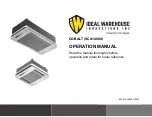
.PRECAUTIONS ON INSTALLATION
<Drain work>
Potentially problematic locations for the outdoor unit drainage. In
locations where, for example, drain may fall on passersby may cause
passersby to slip over, install in enclosure (field supply) to prevent
people approaching the outdoor unit.
Then, coat the area around the bored holes with rust preventive
coating to cover the metal exposure.
• Make sure the drain works properly.
<Installation method of the outdoor unit>
• Check the strength and level of the installation ground so that the
outdoor unit will not cause any operating vibration or noise after installed.
• In accordance with the foundation drawing in Fig. 3, fix the unit
securely by means of the foundation bolts. (Prepare four sets of
M12 foundation bolts, nuts and washers each which are
available on the market.)
)
lO
"'
C\J
"'
Outlet Side
0
(Units: mm)
160
620
160
co
20
Bottom frame
36
• It is best to screw in the foundation bolts until their length are 20 mm
from the foundation surface.
Diagram of lower surface
• Fix the outdoor unit to the foundation bolts using nuts with resin
washers. (See the right-hand drawing )
If the coating on the fastening area is stripped off, the nuts rust easily.
<Installation method of fixure for preventing overturning>
• If steps need to be taken to prevent the unit from tipping over.
Use the fixure for preventing overturning (option).
REFRIGERANT PIPING WORK (1/5)
Fig. 3
!l
�
Drawing of the foundation
6
CAUTION
I
To plumbing persons
I
Fixure for preventing
overturning (option)
(wiring system)
• Important information regarding the refrigerant used. This product contains fluorinated greenhouse gases covered by the Kyoto Protocol.
Do not vent gases into the atmosphere.
GWP (global warming potential) of R32 refrigerant type = 675
• Use R32 as additional for charging.
• Do not use flux when brazing refrigerant piping.
Use phosphor copper brazing filler metal (BCuP-2:JIS Z 3264/B-Cu93P-71 Oll95:ISO 3677) that does not require flux.
(If chlorinated flux is used, the piping will be corroded and, in addition if fluorine is contained, the refrigerant oil will be deteriorated and the
refrigerant circuit will be affected badly.)
• After chapter
U
CHARGING REFRIGERANT) is completed, be sure to open the stop valves before performingai)FIELD SETTINGS ).
(Operating the unit with the valve shut will break the compressor.)
((Precaution when reuse existed refrigerant pipe ))
Please keep below points in order to reuse existed pipe, failure may caused if have a fault.
• Below are pipes shall always make new construction, do not reuse piping.
- When removed from indoor unit or outdoor unit for a long time.
(Moisture entry to internal pipe, wastes entry can be occured.)
- When copper tube is corroded.
- When pipe thickness is insufficient (refer to ( 5-4 REFRIGERANT PIPE SIZE AND ALLOWABLE PIPE LENGTH)
- Do not reuse flare for refrigerant leak protection, please make flare processing.
- Do not reuse flare nut, please use flare nut in product accessories.
- Make sure to do refrigerant leak check in case there is brazing area while perform field piping.
- If insulation is deteriorate, make sure to exchange to new one.
(5 1 INSTALLATION TOOLS)
Be sure to use the dedicated tools to ensure sufficient
-
pressure resistance and prevent the entry of any impurities.
Manifold gauge To ensure sufficient pressure resistance and prevent the entry of any impurities (mineral oils such as Suniso oil and liquids),
Charging hose
use the R410A or R32 dedicated item (the screw specifications for R410A or R32 differ).
Vacuum pump
Be extremely careful not to flow the pump oil backward to inside the piping when the pump is stopped.
Use a pump which enables vacuuming to -0.1 MPa(-755mmHg) of the gauge pressure.
( 5-2 SELECTION OF PIPING MATERIAL)
• Use the piping whose inside and outside are clean and with no harmful substances for use such as sulphur, oxide,
dust, dust from cutting, grease, or liquid (contamination) is attached.
• For the refrigerant piping, use the following material.
Material: Deoxidised phosphorous seamless copper piping
Temper grade: Use piping with temper grade in function of piping diameter as listed in the table on section
( 5-4 REFRIGERANT PIPING SIZE AND ALLOWABLE PIPING LENGTH )
Size: Decide based on section (5-4 REFRIGERANT PIPING SIZE AND ALLOWABLE PIPING LENGTH )
Thickness: Comply with applicable legislation. The minimal piping thickness for R32 piping must be in accordance with the table on section
( 5-4 REFRIGERANT PIPING SIZE AND ALLOWABLE PIPING LENGTH)
• For the handling of the stop valves, see "precautions when the handling piping stop valves" on section
ls-4 5EFRIGERANT PIPING WORK
• Be sure to perform piping work using measurements within the maximum allowable length and height difference described on section
(5-4 REFRIGERANT PIPING SIZE AND ALLOWABLE PIPING LENGTH )
27
Summary of Contents for FDMA125AV16
Page 22: ...4 15 3 30 RZA125AV16 RZA140AV16 RZA125AV16 RZA140AV16...
Page 50: ...49...
Page 51: ...50...
Page 52: ...51...
Page 53: ...52...
Page 54: ...53...
Page 55: ...54 49 48 49 50 50...
Page 56: ...55...
Page 58: ...MEMO...
Page 59: ...MEMO...
Page 60: ...MEMO 3P727715 6 B...
















































